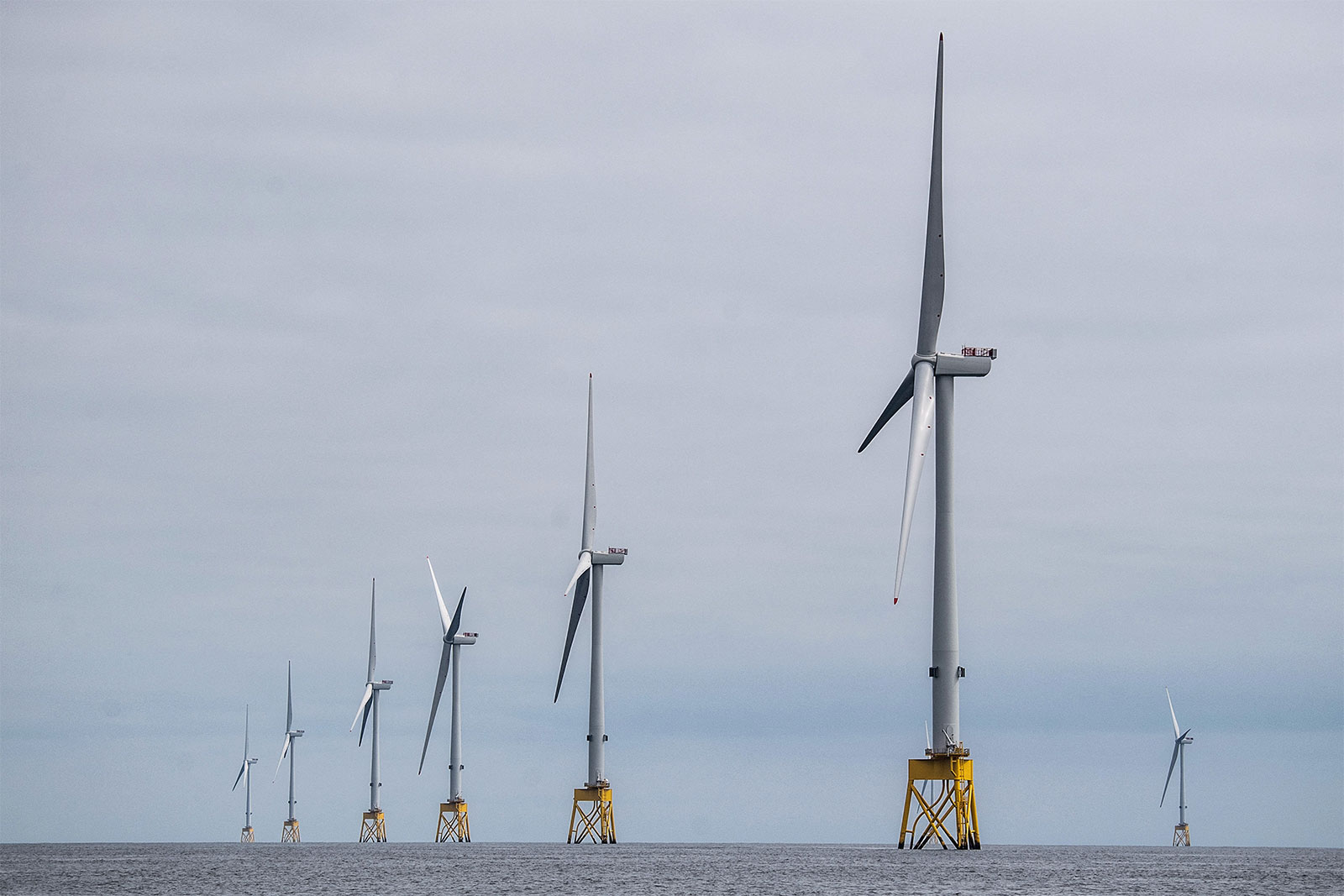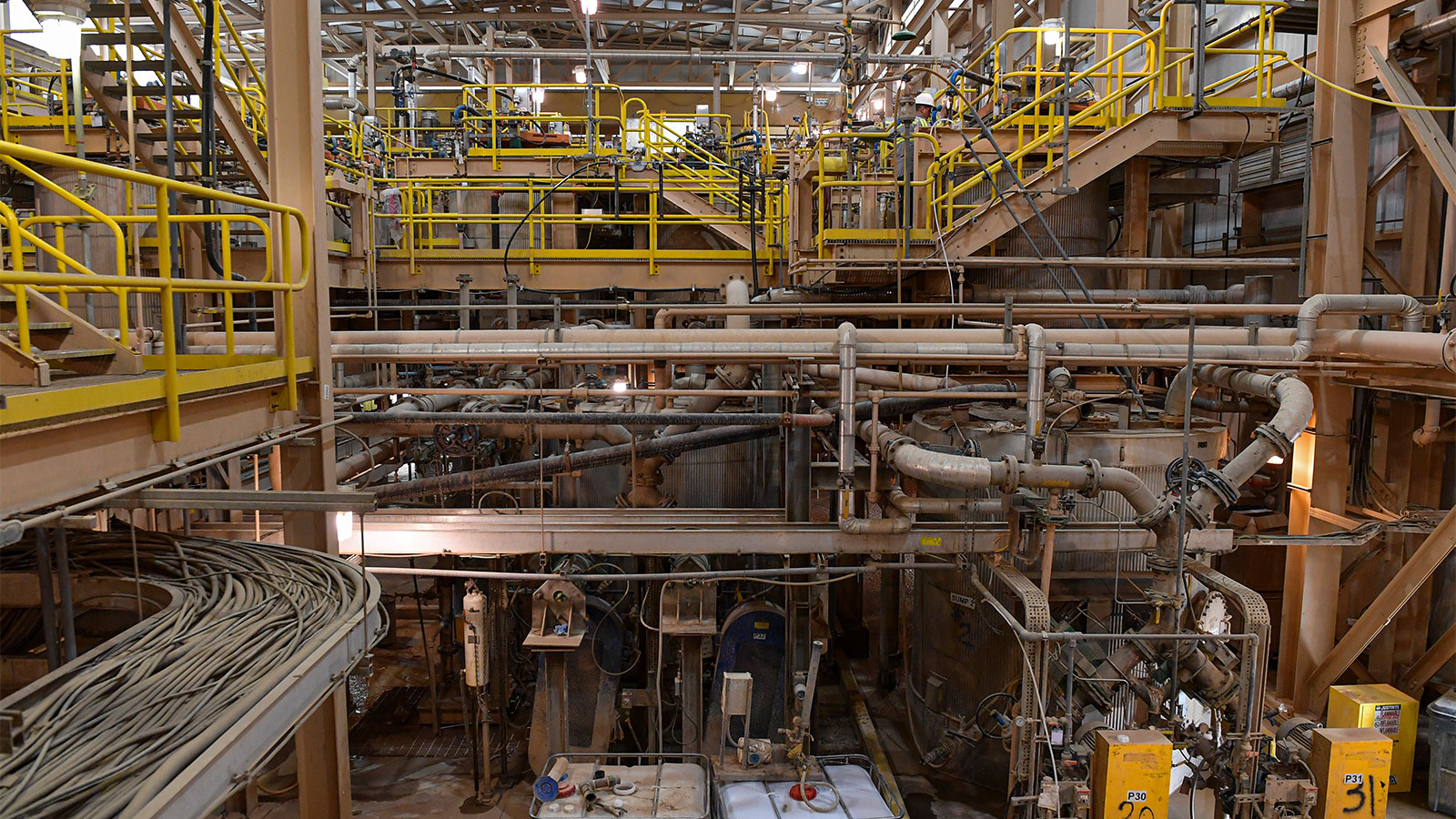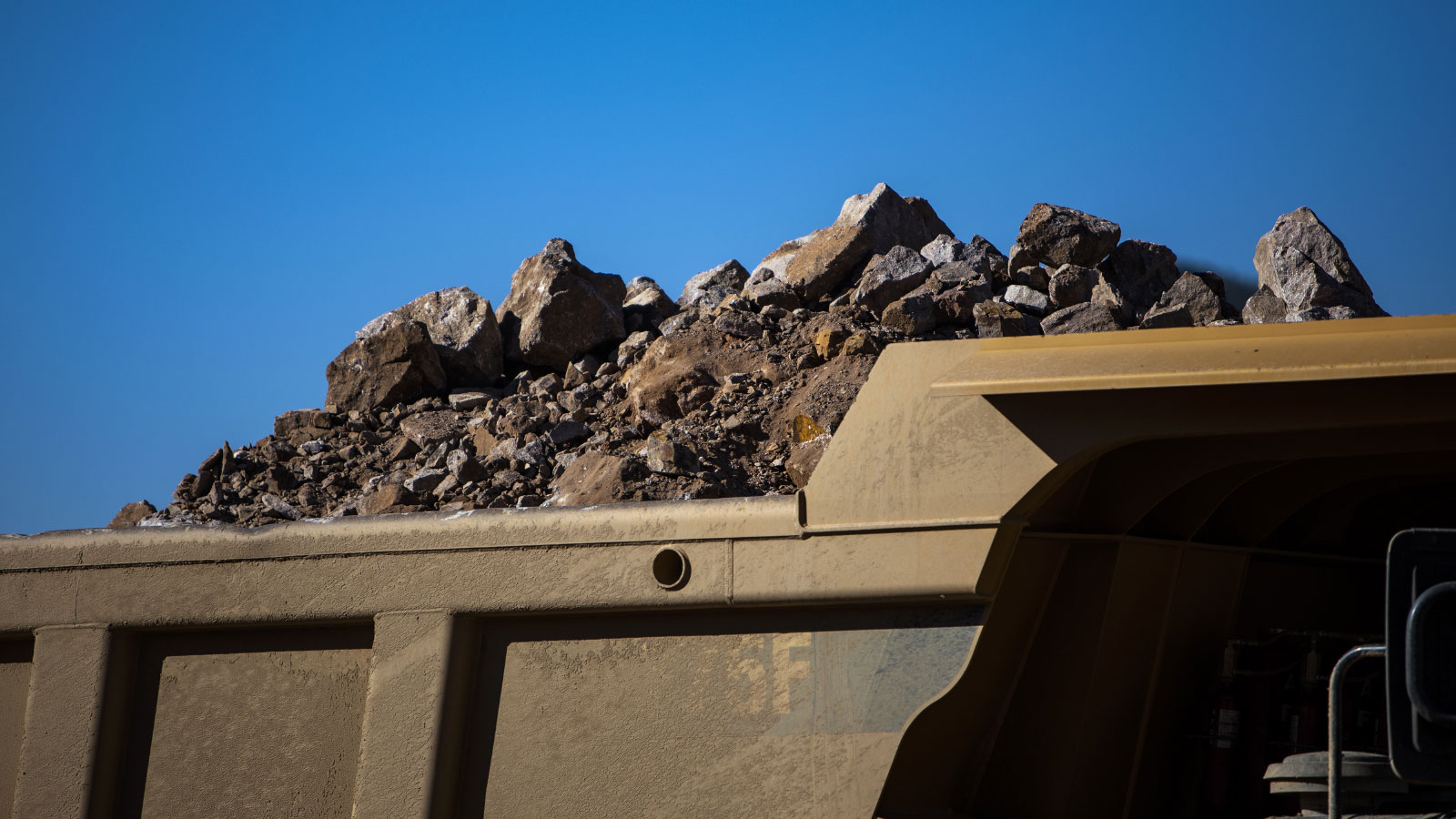In arid southeastern California, just across the border from Nevada, sits the only large-scale rare-earth element mine in the Western Hemisphere. Here at Mountain Pass, rocks are dug out of a 600-foot pit in the ground, crushed, and liquified into a concentrated soup of metals that are essential for the magnets inside consumer electronics, wind turbines, and electric vehicles, or EVs.* Today, that metallic soup is shipped to China, where individual rare earths are separated before being refined into metals and forged into magnets. But MP Materials, the company that took ownership of the 70-year-old Mountain Pass mine in 2017, hopes to change that. This quarter, MP Materials plans to begin separating rare earths at Mountain Pass — the first time this key processing step will have occurred in the United States since 2015.
MP Materials says that the new U.S.-based rare-earth supply chain it is building will be greener than its counterparts in Asia, where the mining and processing of rare earths have created nightmarish pollution problems. Some of its domestically processed rare earths will be used to make alloys and magnets for EVs, and others could help renewables developers build the wind turbines the U.S. desperately needs to decarbonize its power sector. MP Materials’ rare earths could also get used in everything from smartphones to military weapons like drones and missiles.
Julie Klinger, a geographer at the University of Delaware who studies the global rare-earth industry, said MP Materials’ new processing capabilities have the potential to be a “best-case scenario in terms of diversifying the global supply chain and also doing so in a comparably robust regulatory environment.” However, Klinger cautioned that from a sustainability perspective, it’s important to minimize new mining overall. That could mean prioritizing the use of rare earths in clean energy versus military applications, or dramatically ramping up rare-earth recycling, an industry still in its infancy.
Owing to their unique atomic structure, rare-earth elements are able to generate stronger magnetic fields than other elements susceptible to magnetization, like iron. As a result, rare earths can be used to create the most powerful commercial magnets on the market today. Within the clean energy sector, they’re used in the types of generators popular for offshore wind turbines, as well as inside the motors of EVs and hybrid vehicles. These magnets get their strength from the “light,” or lower atomic weight, rare-earth elements neodymium and praseodymium, which are often refined together as a compound called NdPr oxide. A pinch of dysprosium or terbium, two of the scarcer and more valuable “heavy” rare-earth elements, is added to the mix to boost the magnet’s heat resistance.

Demand for rare-earth magnets is growing quickly. By 2030, under an aggressive decarbonization scenario, the U.S. EV sector’s rare-earth magnet demand could rise nearly sixfold compared with 2020 levels, according to a recent report by the U.S. Department of Energy, or DOE. Over the same time frame, rare-earth magnet demand for the nascent offshore wind industry could rise from zero to 10,000 tons. These trends mirror what’s expected worldwide: In a report published in April, critical minerals research firm Adamas Intelligence forecasted that the value of the market for rare earths used in magnets will increase fivefold by 2040, driven by rapid growth of the EV and wind energy sectors. By that same year, the world could face a 90,000-ton-per-year shortfall of NdPr oxide, roughly equivalent to total global production in 2022.
As the U.S. competes with other nations for these critical resources, one country dominates their production. In 2020, China was responsible for 58 percent of rare-earth mining, 89 percent of rare-earth separations (including nearly 100 percent of heavy rare-earth separations), 90 percent of rare-earth refining, and 92 percent of magnet-making. While the Chinese government has attempted to reduce the rare-earth industry’s environmental impact in recent years, decades of poorly regulated production, along with illegal mining, have caused significant air and water pollution, leaving behind nightmarish waste ponds filled with heavy metals and radioactive elements. (Rare earths tend to occur alongside the radioactive elements thorium and uranium, resulting in the production of low-level radioactive waste during mining and processing.) In neighboring Myanmar, where illegal rare-earth mining is taking off today, the situation is equally bleak.
MP Materials is positioning itself as an alternative to Asian dominance of the rare-earth supply chain and its questionable environmental legacy. The company assumed ownership of the Mountain Pass mine in 2017 after its previous owner, Molycorp, struggled to become profitable and ultimately filed for bankruptcy.* Since then, MP Materials has been steadily ramping up rare-earth production at Mountain Pass, generating 14,000 tons of rare-earth oxides in 2018, and 28,000 tons the following year. Last year, Mountain Pass produced 42,499 metric tons of rare earths — the highest output in the mine’s history, and 14 percent of the global total.
The revival of Mountain Pass has already reconfigured the global rare-earth mining landscape. Now, MP Materials seeks to redraw the rest of the supply chain. After rare earths are mined and concentrated in liquid form, companies use additional steps like roasting and leaching to separate out impurities and unwanted elements, such as cerium, a low-value light rare earth. From there, a series of chemical extraction processes separate elements of interest. Separated rare-earth oxides are then converted into metals through processes like electrowinning, in which metals are extracted from a solution by running an electric current through it. Rare-earth metals are then pressed, or sintered, into a magnetic block which can be cut into a desired shape.

MP Materials is in the process of investing $700 million to develop all of these capabilities in the U.S. In 2021, the company began upgrading the refinery at Mountain Pass to restore its processing capabilities, including rare-earth separations. According to the company’s earnings call for the first quarter of 2023, the facility will begin separating NdPr oxide this quarter. With the help of a $35 million contract from the US Department of Defense, or DOD, the company is planning additional upgrades to separate the 11 elements classified as medium and heavy rare earths, focusing on the magnet elements dysprosium and terbium. Once these capabilities exist, MP Materials will ship processed rare earths from California to a new facility under construction in Fort Worth, Texas, where they will be used to make alloys and magnets for General Motors EVs.
While the concentrations of dysprosium and terbium in Mountain Pass ore is low, Matt Sloustcher, senior vice president of communications and policy at MP Materials, says MP Materials expects to produce enough of them to “cover the needs of its Texas magnetics factory.” MP Materials’ facilities will also be capable of refining material mined elsewhere, including material with a higher relative abundance of heavy rare earths.
According to Sloustcher, the company’s goal is to begin supplying General Motors with rare-earth alloy later this year, and to produce finished magnets by 2025. At full capacity, MP Materials expects the magnetics factory to produce 1,000 tons of rare-earth magnets a year, supporting the production of roughly half a million EV motors.
Under Molycorp’s ownership in the 1990s and early 2000s, the Mountain Pass mine was beset with environmental scandals related to the handling of radioactive wastewater, which Molycorp pumped into open-air evaporation ponds in the desert. To avoid repeating that history, MP Materials is operating Mountain Pass as a “zero discharge” facility, meaning all of the water it uses is recycled on site, with dry waste buried in lined landfills. It claims to be the only rare-earth mine in the world to use this process.
From an environmental perspective, MP Materials’ water recycling process process is “a really big deal,” said Klinger. “It significantly reduces their waste footprint.”
The refining processes MP Materials is adding will inevitably increase its environmental footprint. Owing to their chemical similarity, separating rare earths from one another is extraordinarily complicated. Separation processes, which can include hundreds of different steps, consume large volumes of water, chemicals, and energy. The company says it is intent on minimizing resource use, and to that end is recycling chemicals throughout its process. In addition, it has introduced a roasting step to remove cerium before attempting to separate other elements, which MP Materials believes will improve the efficiency of the entire process. Cerium comprises nearly half of the rare-earth mixture present in Mountain Pass ore.
Eric Schelter, a professor of chemistry at the University of Pennsylvania who studies rare-earth separations, agrees that this roasting step will make it “relatively simpler” to separate the rare earths of value. But he says that if there is no market for the cerium, it must be disposed of as waste, driving up costs. In general, Schelter cautions that the economics of rare-earth production are challenging and have worked against U.S. industry in the past.
“Personally, I think it would be great” if MP Materials were successful, Schelter said. “This is a really significant need. But ultimately, the marketplace is going to decide that it is, or is not, worthwhile to buy these magnets or buy these materials from them.”
Sloustcher, from MP Materials, agrees that profitably producing rare earths is challenging considering the large quantities of low-value materials that need to be sifted out first, including both cerium and the light rare-earth lanthanum. However, he says the company has identified customers that are “eager for U.S.-produced cerium and lanthanum products,” which are used in water treatment and fuel manufacturing processes, among others. NdPr oxide, Sloustcher says, is the “key commodity that drives economic value” in the rare-earth industry, and MP Materials believes it is “a low-cost NdPr producer globally.” Sloustcher added that the company has already proven it can produce rare earths at a profit for several years.
To ensure no valuable rare-earth material is wasted, MP Materials is also planning to recycle the scrap produced during magnet fabrication, as well as end-of-life magnets. The goal, Sloustcher says, is re-introduce recyclable material at whatever point in the process flow it is most efficient, whether that means using scrap to produce new magnets directly or separating it back to individual elements. Schelter believes that the latter approach will make it easier to scale up recycling, because different types of magnets contain different amounts of rare earths.

An unknown but likely very small fraction of rare earths are recycled at end-of-life today.
“Recycling magnets from phones, hard drives, and wind turbines can provide magnets of different grades,” Schelter said. “Collecting them from different sources would be enabled by a chemistry that purified the individual rare earths back out again.”
Klinger, the University of Delaware researcher, is excited about MP Materials’ interest in rare-earths recycling, and its pitch for a greener supply chain more broadly. However, any new rare-earth production will have an environmental cost, and Klinger says that the extent of the impacts ultimately comes down to our consumption of rare earths — not just for clean energy and personal electronics, but also weapons of war. Rare earths are essential for a variety of defense applications, including drones, missile guidance, tank and aircraft motors, and advanced laser systems. In addition to investing tens of millions in both light and heavy rare-earth processing at Mountain Pass, the DOD recently awarded Australian company Lynas a $120 million contract to build a rare earth separations facility in Texas, expected online in 2025.
The DOD declined to comment on the fraction of rare earths from these new U.S. processing facilities that could ultimately make their way into defense applications. However, a DOD official told Grist in an emailed statement that generally speaking, rare-earth demand for civilian applications like clean energy “vastly exceeds projected defense demand.”
Nevertheless, Klinger worries that military industrial demand for rare earths will rise as conflicts intensify across the world and the global arms trade grows. She suspects that reining in this demand will lead to the “greatest gains” in terms of reducing the need for new mining overall, and she’s in the process of gathering data to explore the idea further.
“I am a little concerned,” Klinger said, “by what the overemphasis on the energy transition might be covering up.”
*Correction: This story originally misstated the depth of the pit at Mountain Pass. It also misspelled the name of Mountain Pass’s previous owner.



